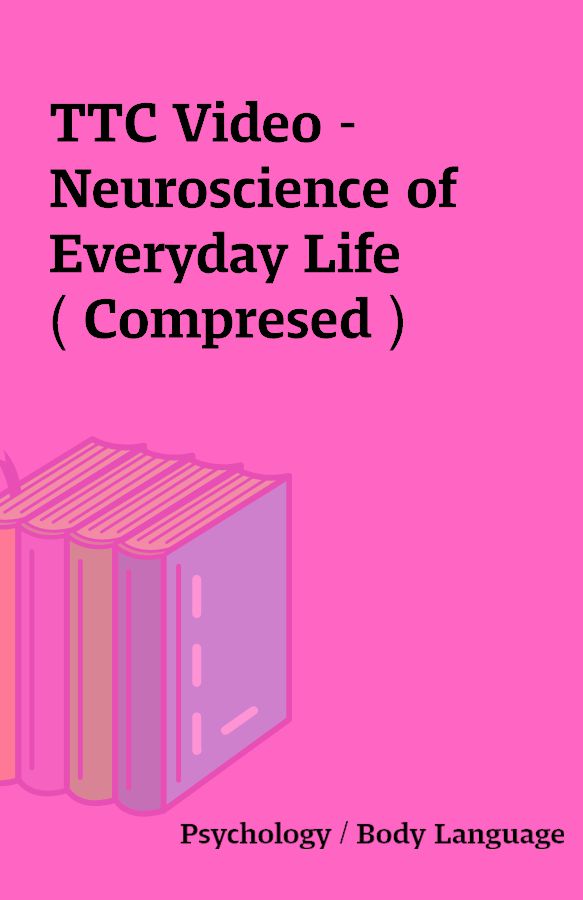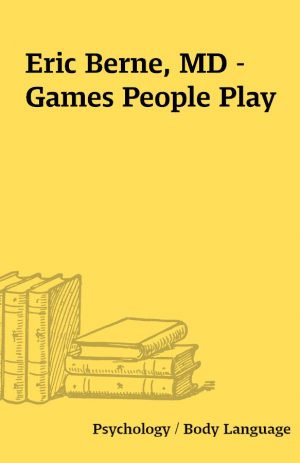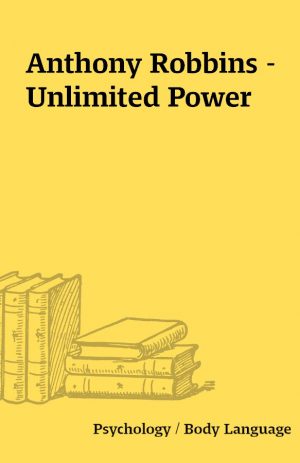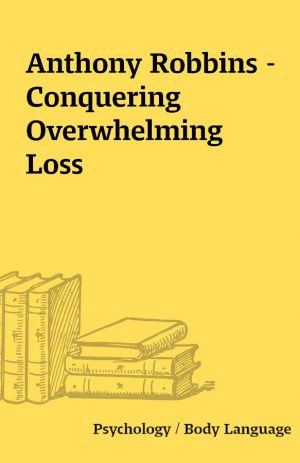TTC Video – Neuroscience of Everyday Life ( Compresed )
TTC – Neuroscience of Everyday Life (compressed)
[ 36 AVI – 1 PDF ]
Description
This is a compressed version of of Everyday LifeTaught By Professor Sam Wang, Ph.D., Stanford University,Princeton UniversityCourse No. 154036 Lectures30 minutes / lectureCourse Lecture Titles1. What Is Neuroscience? Launch your investigation into neuroscience, a field that can explain many aspects of human behavior. After taking a brief tour of the brain, preview three classic problems on which neuroscience has shed new light—on the perception of red, dreaming, and early development.2. How Do Neuroscientists Study the Brain? Professor Wang introduces the key approaches used by neuroscientists, each of which gives a different kind of evidence about the brain. Look at what neuroscience has to say about two common beliefs: alcohol kills neurons, and classical music makes babies smarter.3. Evolution, Energetics, and the 10% Myth Analyze how brains are similar across a wide range of species and how energy use in the brain allows the imaging of cognitive function. Also investigate two persistent myths about the brain: that it works like a computer, and that we use only about 10% of its capacity.4. Neurons and Synapses The brain operates on just 15 watts of power—about the power of a refrigerator light bulb. See how this current translates into all the phenomena of the brain by examining the chemical pathways that neurons use to communicate across synapses.5. Neurotransmitters and Drugs Neurons “talk” to each other through neurotransmitters. Study how these chemicals act on special receptor molecules and how drugs can alter this system. The most abundant neurotransmitters are glutamate, GABA, and glycine. Supplementing these, the biogenic amines norepinephrine, dopamine, and serotonin play important roles in attention, reward, and mood.6. Juicing the Brain How do drugs work on the brain? Why are some chemicals addictive and others not? Explore the neuroscience of an array of psychoactive substances, including caffeine, marijuana, cocaine, amphetamines, nicotine, opiates, L-dopa, and Ritalin. Each works by imitating or altering the action of neurotransmitters.7. Coming to Your Senses Trace the origins of your senses of touch, taste, smell, hearing, and vision, each of which results from a cascade of events at the molecular level. Discussing many examples, Professor Wang looks at why MSG tastes so good, loud music causes hearing loss, and men are more likely to be color blind than women.8. Perception and Your Brain’s Little Lies At any given moment, your brain is probably lying to you. Although you think you perceive the world directly, your brain analyzes stimuli in ways that may not reflect reality. Experience a startling example with the “stepping feet” illusion.9. Pain—All in Your Head? Pain is a perception generated entirely within the brain, yet it announces that something is drastically wrong. Learn that the intensity of pain depends on the context of an injury. Also investigate how pain responds to different drugs, meditation, and acupuncture.10. Decisions—Your Brain’s Secret Ballot When making decisions, are you a maximizer or a satisficer? The first seeks the best possible outcome from an array of options; the second is satisfied with a swift decision from limited choices. Studies show that our brains often make up our minds before we are aware of it.11. Reward, Adaptation, and Addiction Reward and addiction are two sides of the same coin. Examine how dopamine-secreting neurons reinforce behaviors that are beneficial to the organism. Unfortunately, certain drugs target these same neurons and put the reward system into overdrive, resulting in physical addiction.12. The Many Forms of Memory Chart the famous case of H. M., who lost the ability to form new memories after an operation for epilepsy. The tragic outcome sheds light on the location of different components of memory. Also probe the connection between declarative memory and our ability as animals to find our way in the world.13. Quirks of Memory Memory evolved to deal with fear, spatial navigation, and factual knowledge. It can be rewritten and strengthened, but also altered in the rewriting. Study the quirks of memory that show up in source amnesia, post-traumatic stress disorder, and the formation of false beliefs.14. Learning, Studying, and Sleep Learn what it means to learn at the cellular level by focusing on two key principles: cells that fire together wire together; and out of sync, lose your link. Then get tips on how to study most effectively based on what neuroscience has discovered about learning. Finally, investigate the role of sleep in consolidating new knowledge.15. Willpower and Mental Work Willpower draws on a finite mental resource. Look into the famous “marshmallow study” with four-year-olds, which showed the far-reaching effects of childhood self-control on later life. Next, learn strategies for harnessing willpower most effectively, including the trick of brushing your teeth with your nondominant hand.16. Work, Play, and Stress You don’t want to be too relaxed. Study the role of stress as an adaptation to best respond to uncertainty or danger. Stress also has an intimate relationship to play. Trace the stress response from its source and learn the detrimental effects of chronic stress on the body and brain.17. Biological Timekeepers and Jet Lag Anyone who travels quickly across several time zones is tinkering with the brain’s circadian clock. Explore this biological timekeeper, which is located in the hypothalamus and takes its cues from light entering the eyes—a mechanism that suggests a strategy for combating jet lag.18. The Hidden Talents of Infants Begin a series of lectures on the developing brain by focusing on infants. Around three months of age, babies are learning to acquire information in five ways: by noticing rare events, reasoning from cause to effect, distinguishing objects from agents, categorizing, and discarding irrelevant information.19. The Mozart Myth and Active Learning The Mozart myth is the widespread belief that playing classical music to babies increases their intelligence. Discover what is really going on in young minds, which need only normal experiences to thrive. Professor Wang offers advice on the best strategy for nurturing learning in children.20. Childhood and Adolescence The most rapid changes in the brain happen before the age of six, but growth and maturation continue all the way through adolescence and beyond. Track the nature of this growth and how it explains the propensity of adolescents for risk-taking, hyperactivity, and short attention spans.21. Handedness—Sports, Speech, and Presidents Why are humans so overwhelmingly right-handed? What does this tell us about left-handed people? Look into the possible sources of this trait and the reason lefties excel at some sports but not others. Intriguingly, a possible connection with language processing may explain why several recent U.S. presidents have been left-handed.22. Reaching the Top of the Mountain—Aging The brain continues to change throughout life. Assess these transformations at the level of neurons and see how they affect large-scale traits such as memory, verbal comprehension, and emotional control; the last two actually improve with age. Also consider debilitating changes such as Alzheimer’s disease and stroke.23. “Brain Exercise” and Real Exercise How useful are brain-training exercises such as Sudoku puzzles? Discover that interpreting the ambiguous research results is a brain exercise in itself! Compare the limited benefits from these activities with the more robust cognitive effects of physical exercise, in which what helps the heart also boosts the mind.24. Animal and Human Personality Starting a series of lectures on individual differences in brains, probe personality in humans and animals. Personality is a complex of traits that are partly inherited. On the other hand, shyness and anxiety are two attributes that can sometimes be reversed through early intervention.25. Intelligence, Genes, and Environment Fluid intelligence is the ability to reason through an unfamiliar problem. Discover that there is a strong inherited component to this ability. However, under conditions of deprivation, fluid intelligence is mostly environmentally determined. Also see how intelligence test performance can be influenced by prior expectations on the part of the test taker.26. The Weather in Your Brain—Emotions Investigate the essential function of emotions and where they originate. One emotional phenomenon—blushing—raises an intriguing question: Is it the effect of embarrassment or the cause, and what does this tell us about other emotions? Finally, look at the link between disgust and the moral sense.27. Fear, Loathing, and Anger Probe deeply into primal emotions that originate in the brain’s hippocampus, hypothalamus, and amygdala: namely anger, rage, fear, and anxiety. Evolution has equipped us to learn a specific fear after only a single experience, but unlearning the same fear requires prolonged conditioning.28. From Weather to Climate—Mood Mood is to emotion as climate is to weather; that is, mood is a long-lasting phenomenon. Delve into the nature of moods, which in their most extreme forms constitute major psychiatric problems. Finally, examine treatments for depression and other mood disorders.29. The Social Brain, Empathy, and Autism Whether you realize it or not, as you watch these lectures you are deploying a theory of mind about Professor Wang’s thoughts and motivations. Look more closely at this remarkable faculty—the social brain—by investigating a neurological disorder where it appears to be absent: autism.30. Mars and Venus—Men’s and Women’s Brains While the brains of other animals often show striking differences between the sexes, male and female humans have remarkably similar brains. Learn the nature of our hormone-driven differences, for example, in toy preference, spatial reasoning, and susceptibility to certain neurological disorders.31. Sex, Love, and Bonds for Life Trace the source of human sexual behavior to the hypothalamus, where secretion of the hormones vasopressin and oxytocin play a role in the full range of sexual expression—from love and attachment to mating, birth, and bonding between mother and infant.32. Math and Other Evolutionary Curiosities Turn to two evolutionary curiosities that are uniquely human: humor and mathematics. Neither seems to provide a survival advantage through natural selection. Or do they? Professor Wang looks at the origins and function of humor. Then he searches for the roots of our mathematical ability.33. Consciousness and Free Will Investigate two big ideas where neuroscience intersects philosophy: consciousness and free will. In exploring the many facets of consciousness, discover that we may be overrating it as a cause of behavior. Free will is even more difficult to evaluate and raises the question: Are we agents or are we robots?34. Near-Death and Other Extreme Experiences Plumb the depths of extreme experiences to learn what neuroscience has to say about near-death visions, out-of-body experiences, haunted houses, and other paranormal phenomena. In each case, the brain appears to be trying to piece together a story from incomplete or highly unusual data.35. Spirituality and Religion How does the human brain lead to spirituality and religion? Chart the synchronous firing of neurons that accompanies deep meditative states. Then draw on what you have learned in the course to explore the role of the brain in finding transcendent meaning in the world through religion.36. Happiness and Other Research Opportunities Conclude the course by exploring a mysterious brain function that looms large for practically everybody: happiness. Finally, survey some of the new research trends in neuroscience that are leading to a deeper understanding of the everyday wonders of the human brain.Your nervous system is you. All the thoughts, perceptions, moods, passions, and dreams that make you an active, sentient being are the work of this amazing network of cells. For many centuries, people knew that this was true. But no one was sure how it happened.Now, thanks to the exciting new field of neuroscience, we can chart the workings of the brain and the rest of the nervous system in remarkable detail to explain how neurons, synapses, neurotransmitters, and other biological processes produce all the experiences of everyday life, in every stage of life. From the spectacular growth of the brain in infancy to the act of learning a skill, falling in love, getting a joke, revising an opinion, or even forgetting a name, something very intriguing is going on behind the scenes.For example, groundbreaking research in the past few decades is now able to explain such phenomena as these: * Decisions: Studies of decision making at the level of neurons show that our brain has often committed to a course of action before we are aware of having made a decision—an apparent violation of our sense of free will. * Memory: Memory is composed of many systems located in different parts of the brain, which means that you can forget your car keys (information stored in the neocortex) but still remember how to drive (a learned skill requiring the striatum and cerebellum). * Willpower: Willpower is more than a metaphor; it’s a measurable trait that draws on a finite mental resource, like a muscle. While any given individual has a consistent willpower capacity throughout life, it can be strengthened through training—again, just like a muscle. * Religion and spirituality: Three mental traits appear to be essential for the development of organized religion: the search for causes and effects, the ability to reason about people and motives, and language. Mystical experiences also trace to specific activities of the brain.Opening your eyes to how neural processes produce the familiar features of human existence, The Neuroscience of Everyday Life covers a remarkable range of subjects in 36 richly detailed lectures. You will explore the brain under stress and in love, learning, sleeping, thinking, hallucinating, and just looking around—which is less about recording reality than creating illusions that allow us to function in our environment.Your professor is distinguished neuroscientist and Professor Sam Wang of Princeton University, an award-winning researcher and best-selling author, public speaker, and TV and radio commentator. Professor Wang’s insightful and playful approach makes this course a joy for anyone who wants to know how his or her own brain works. And his vivid, richly illustrated presentation assumes no background in science.Fact or Fiction?Professor Wang points out that a lot of what we think we know about our brains turns out to be wrong. While bringing you up to date on the latest discoveries in the field, he debunks the following persistent myths: * We use only 10% of our brains: Your brain is actually running at 100%! The myth about idle brain power has been promoted by self-help gurus and doesn’t stand up to evidence from cases of brain damage, which always cause deficits in function. * Mozart makes babies smarter: Playing classical music may help calm you down around an infant, but it’s not doing anything for the baby. The better strategy is to have children learn to play a musical instrument when they’re older, which does improve brain development. * Women are moodier than men: Studies show that the sexes are tied in the moodiness contest, with men reporting just as frequent mood swings as women. However, both men and women tend to remember women’s mood swings better. * We lose brain cells as we age: The brain is supposedly unique as an organ because it stops adding new cells after birth. In fact, some parts of the brain keep producing new neurons throughout life. The brain shrinks somewhat with age, but its neurons live on.Tune Up Your Brain!Operating on about the power consumed by an idling laptop, the brain has often been compared to a computer. But this, too, is a myth. Computers are logically straightforward in design, whereas the brain is a marvel of evolutionary makeshift, with layer upon layer of systems that started out with one function and then were adopted for something completely different. Some of the most primitive functions of the brain, such as the fight-or-flight response to danger, resist being overridden by the brain’s powerful reasoning center, which evolved more recently.Indeed, much of what the brain does is beyond our conscious control. Yet in some cases, there are ways to intervene. Here are some tips that Professor Wang offers to make your brain run at its optimum: * How to stick to a health regimen: If you use your nondominant hand to brush your teeth for two weeks, this can lead to a measurable increase in your willpower capacity. People who do this are then able to follow a diet or exercise program better. * Efficient learning: Don’t cram! Spread out your study over several sessions. This allows your brain time to process what you’ve learned, which requires no additional effort on your part and greatly increases your retention of information. * Resetting your biological clock: The best way to beat jet lag is to use light, which cues your brain to where it is in the day/night cycle. For a flight between the United States and Europe, in either direction, a dose of afternoon sunlight after you arrive should help you adjust. * The best brain exercise is real exercise: Cognitive functions that normally deteriorate with age, such as memory and response time, can be boosted by aerobic exercise. The effect is largest if you are active starting in middle age, but it’s never too late to start.The Research Subject Is YouTurning from processes that are merely hidden to those that are utterly mysterious, The Neuroscience of Everyday Life also sheds light on these phenomena: * Love: Prairie voles are a fascinating model for studying human mating, since, unlike most other mammals, they are monogamous. For them as well as for us, the neurotransmitters oxytocin and vasopressin control the expression of pair bonding, better known as love. * Humor: Smiles and laughter are two emotional components of humor that have deep roots as social signals. Another component is characterized by the sudden flash of insight that occurs when we “get” a joke; brain scanners show where this happens. * Haunted houses: Neurological phenomena that people have associated with haunted houses, such as the feeling of an invisible presence, also occur from carbon monoxide poisoning—a once-common problem in houses lit with gas. Reports of haunted houses have dropped sharply with the decline in gas lighting. * Consciousness: Our conscious awareness extends to only a fraction of the stimuli registered by our brains, like a spotlight focusing on a tiny portion of a flood of data. Experiments show that we often act on unconscious information without being aware of it.Professor Wang notes that it was his fascination with consciousness, free will, and other big ideas that led him to switch from physics, which he studied as an undergraduate, to a field he regards as even more alive with possibilities for breakthroughs that will change our worldview in fundamental ways.That field, of course, is neuroscience. The Neuroscience of Everyday Life is your chance to explore a discipline that is now going through its golden age, with the advantage that the subject is not some abstract entity.It’s you.About Your ProfessorDr. Sam Wang is Associate Professor of Molecular Biology and Neuroscience at Princeton University. He earned his B.S. in Physics from the California Institute of Technology and his Ph.D. in Neurosciences from the Stanford University School of Medicine.Dr. Wang is a well-known researcher in the field of neuroscience and has published more than 50 papers in peer-reviewed journals. His work includes the discovery that learning mechanisms can act like all-or-none switches, and that bird and mammalian brains share similar architectures for generating complex social relations. Dr. Wang is also the coauthor of the best-selling popular book, Welcome to Your Brain: Why You Lose Your Car Keys But Never Forget How to Drive and Other Puzzles of Everyday Life. The book has been translated into more than 20 languages and received the AAAS/Subaru Science Book of the Year Award in the Young Adult category.Professor Wang has been widely honored for his scholarship and his advances in neuroscience. He has been the recipient of an Alfred P. Sloan Fellowship, the Rita Allen Foundation Young Scholars Fellowship, a Distinguished Young Investigator Award from the W. M. Keck Foundation, and a CAREER award from the National Science Foundation. He was also selected by the American Association for the Advancement of Science as a Congressional Science and Engineering Fellow, and he served on the staff of the U.S. Senate Committee on Labor and Human Resources.Available Exclusively on DVDBecause of the highly visual nature of the subject matter, this course is available exclusively on DVD. It features more than 1,000 visual elements including a detailed three-dimensional model of the brain, rich graphics and illustrations, and helpful on-screen text.
You must be logged in to post a review.






Reviews
There are no reviews yet.